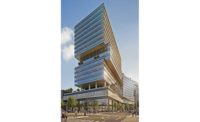Nearly 50 years after the firm started as a home-based business in 1965, engineering and planning firm Pond and Co. decided it was time to grow—by rapidly expanding its workforce. With engineering talent in high demand across the industry, the goal of roughly doubling its staff was indeed ambitious.
In 2014, Pond and Co.’s full-time staff numbered 260—a modest number given the fact that the diversified firm had business throughout Georgia as well as across the Southeast and, to a lesser degree, the rest of the country. The Peachtree Corners, Ga.-based firm had long established its bona fides by delivering a range of design and planning services, including assignments related to transportation, structural, environmental, life safety, MEP, fueling systems and civil and site engineering projects.
But Pond saw plenty of business opportunity ahead for design firms with the resources and talent to meet the demand. So leadership set a goal of reaching a total of 520 employees—doubling the number of staff—by the year 2020. Launched on July 1, 2014, Pond met its the ambitious target well ahead of schedule, achieving it by June 2017.
The reason was not just to grow revenue, says Jeff Meier, chief operating officer. Instead, he says, “It’s to create opportunity for all of our staff” and to build high-performance teams.
“There’s a direct connection between the kind of culture that they’ve built and the bottom-line business success.”
– Michael Sullivan, ACEC of Georgia
The growth initiative, dubbed 520x2020, accelerated Pond’s professional growth, says Erik Grandowski, vice president of marketing and communication.
“Doubling the firm takes leadership on all levels,” he says, adding that the initiative “provided a record number of promotions and internal advancement within Pond.”
Explains Meier: “Great people are going to want to come to great companies. And great people are also going to want opportunities. That’s the main reason we’re really committed to the growth.”
Meier and other Pond leaders can use the term “great” when referring to their firm with some justification. The company has garnered national recognition from Zweig-White’s “Best Places to Work” program. And, for the past two years (2017 and 2018), was named Georgia Engineering Employer of the Year by the Georgia chapter of the American Council of Engineering Companies (ACEC).
Michael Sullivan, president of the Georgia ACEC, sees Pond’s growth as a direct result of its efforts related to its workplace culture.
“I think there’s a direct connection between the kind of culture that they’ve built and the bottom-line business success and growth that they’ve experienced,” he says. With the industry’s keen competition for engineering talent, Sullivan adds: “Culture can make all the difference.”
In recognition of its efforts to grow and develop its own workforce to deliver improved results, ENR Southeast recognizes Pond as its Southeast Design Firm of the Year.
Company Growth
Pond lists its major areas of emphasis as aerospace/aviation; architecture/interiors; community development; defense; energy; facilities engineering; and transportation. The firm also acts as a construction manager, mostly for certain projects where it is already performing design or inspection work.
The energy sector has been one of Pond’s most “dynamic” over the last decade, says Lorraine Green, executive vice president and group leader.
The firm’s work in this sector has “morphed because of our clients,” she says. “We’ve just kept expanding our services based on the requests of our clients. Now we’re pretty much a one-stop shop.”
Working on pipelines and facilities in both the natural gas and liquids markets, the firm’s energy-sector services can include process engineering, coating design and inspection of new facilities as well as mechanical integrity inspections for existing ones.
Other projects falling under Pond’s energy umbrella include aviation fueling systems for military and commercial owners as well as erosion control for a variety of markets. Geographically, Pond’s energy work includes projects in Europe, the Pacific Rim and the Middle East, Green adds.
Other growing markets include transportation and community development, which includes parks and trails, for instance.
Transportation projects run the gamut from interstate projects to roundabouts and other, “traffic-calming” designs. Ron Osterloh, senior vice president, says a focus on local municipalities also led to an expansion of services.
In response to the staffing limitations that many cities and counties face, the firm has expanded its planning services for both transportation and community development projects, says Osterloh, who leads both segments.
“There are a lot of local municipalities that just can’t handle their work load, so we do plan reviews for them, or inspections, and serve as that value-added resource,” he says. “It helps maximize their money, and it helps us understand the project before it gets to the design phase.”
A related project that recently garnered industry accolades was Mableton, Ga., Town Square, which earned a Design Merit award from ACEC Georgia. Here, the firm integrated roadway engineering and an unusual approach to traffic engineering, landscape architecture and lighting design in an effort to revamp an underutilized section of Mableton into a town square.
The project addressed the Mableton redevelopment district’s plan of creating a community that accommodates its aging population, where “residents are able to age gracefully in a thriving community,” Matt Wilder, Pond director of landscape architecture, said when accepting the award.
Another award-winning project reflecting Pond’s community-development practice is the 15-mile Big Creek Greenway project in Forsyth County, Ga. The last phase of that multiyear project is currently under construction, Osterloh says.
Going to School
A specific driver behind Pond’s performance and growth is the emphasis on creating high-performance teams, says Tony Parker, president and CEO. At the center of that effort is Pond University, an initiative started about six years ago aimed at improving the leadership and relationship skills of a select group of emerging company leaders. It’s a major effort, with the company estimating that it invests roughly $1 million developing Pond U.’s annual class of roughly 20-24 “students,” who come from a range of positions. Company executives take turns leading two-day, offsite sessions held every other month, with an early focus on each individual’s potential “derailment” issues.
“If you’ve got some character flaws or issues in your personality that cause the team to not operate as effectively as they should, you have to be aware of those things, which (can be) very unnerving,” Parker explains. “It’s all about building trust, and that’s essential to having a high-performance team.”
Adds Pam Gower, human resources director: “We’re really all about relationships in our organizations, and that really starts with the relationships we have with each other.”
The educational initiative appears to be producing the intended results. Kathryn Masters, director of airside/landside/cargo, planning and development at Hartsfield-Jackson Atlanta International Airport, says the Pond team—which is partnered with Michael Baker International as engineer of record for civil projects—provides “a level of collaboration you don’t always get” from other firms. Pond has been serving in this role for approximately 10 years.
“As an owner, we have a strong opinion about how we think things should be done,” Masters says, adding that Pond does “a good job of listening to that and respecting that, but also being willing to come in with their own ideas.”
Of the Pond-Michael Baker team, Masters adds, “They do good work, they’re responsive and they communicate well.”
Sullivan with ACEC Georgia says Pond University is “one of the leading internal leadership and business development programs” among the association’s member firms.
The difference between Pond U. and other, similar programs, Sullivan believes, is that Pond’s initiative is “part of a much larger, broader, deeper commitment to building a culture of inclusiveness (and) valuing employee perspectives.”
While the program itself stands out, Sullivan adds, “It’s that larger culture that Pond has created that is the real key” to its growth.
Pond currently targets a robust 20% annual growth rate, which Meier says “creates opportunities for the great people we’re hiring.”
“It is challenging growing the company,” he adds, “but we make it fun.”









